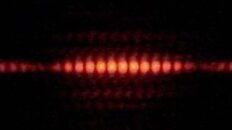TRANSCRIPT:
There are two fundamental constants of nature related to spacetime’s discreteness. They’re called Plank length and Planck time. Plank length is the smallest length scale with any physical meaning. Planck time is the smallest unit of time that we can meaningfully measure.
Loop quantum gravity is a theory that’s concerned with the quantum properties of spacetime. The idea is that spacetime is a network of nodes and links in which quantum properties are assigned. In essence, spacetime is built up of discrete chunks.
With causal set theory, spacetime is not a smooth, continuous fabric, as defined by general relativity. It consists of discrete, indivisible building blocks called events that are causally related to each other to help form a causal structure.
ust to start, we’re going to be speaking a lot in broad terms here because with this subject we can quickly get in the weeds.
Okay, so there’s a divide between quantum mechanics and general relativity. You all know this, but let’s just get this out of the way.
Whereas general relativity describes how gravity affects the fabric of spacetime.
This theory underlies our understanding of space, time, and gravity. It treats gravity as a curvature in spacetime.
When an object bends spacetime’s fabric, it makes a gravitational “well” at the location where anything with mass resides.
But general relativity doesn’t appear to fit into quantum mechanics, even though three fundamental forces of nature do because they’re mediated by particles.
By the way, those three fundamental forces of nature are electromagnetism, the weak nuclear force, and the strong nuclear force.
General relativity does imply that galaxies should be racing apart, but the reasons why are up for debate.
General relativity passes all the tests thrown at it and successfully explains gravitational interaction at a macro level.
But things get whacky when scientists try to calculate space’s curvature around an electron or other quantum objects.
Quantum fluctuations of spacetime also happen at distances super close to the center of black holes.
When trying to outline the gravitational field of a black hole using general relativity, the spacetime curvature diverges at the center.
This signals a breakdown of the theory. It also means we need a new theory that includes both general relativity and quantum mechanics.
This is where the theory of quantum gravity comes in. Scientists have tackled it in a variety of ways.
But maybe we don’t have the right theory yet.
Or maybe we do.
There are a couple of theories for quantum gravity.
According to the theory, when the strings vibrate, twist, and fold, they produce effects in several tiny dimensions.
And then we interpret that as everything from particle physics to gravity.
It’s been proposed often as a possible “theory of everything” that brings together quantum mechanics and general relativity.
Then you have loop quantum gravity, a theory that’s concerned with the quantum properties of spacetime.
The idea is that spacetime is a network of nodes and links in which quantum properties are assigned.
In essence, spacetime is built up of discrete chunks.
Imagine zooming in to spacetime. As you do so, you’d see that time doesn’t move into the future continuously but in quick little ticks of a discrete clock.
A new theory has been recently put forward that takes a unique approach. And it may have massive implications.
It’s called causal set theory, and it’s a framework that describes spacetime’s structure.
In this theory, spacetime consists of discrete elements called “events” that are related to each other through causal relationships.
Imagine a collection of dots on a piece of paper. Each dot represents an event in spacetime. The lines that connect them represent the causal relationships between them.
If event one causes event two, a line will connect one to two on the paper.
One of the main ideas of this theory is that the universe is fundamentally discrete instead of continuous.
In other words, spacetime is not a smooth, continuous fabric, as defined by general relativity.
It consists of discrete, indivisible building blocks called events that are causally related to each other to help form a causal structure.
There are two fundamental constants of nature related to spacetime’s discreteness. They’re called Plank length and Planck time.
Plank length is the smallest length scale with any physical meaning. Planck time is the smallest unit of time that we can meaningfully measure.
With causal set theory, Planck length and time are believed to represent the smallest possible distances and times between spacetime events.
This means that spacetime is granular.
Traditionally, spacetime was thought of as smooth. Massive objects interact with it, causing it to bend. This is what we perceive as gravity.
But causal set theory suggests the opposite. Singularities can’t happen because the chunks of spacetime can’t get infinitely close together.
If there are no singularities, this means there is no Big Bang. The universe has always existed, and time has no beginning.
Causal set theory at its core is based on partial order relation. That’s a mathematical concept used to describe a set of events that have a cause-and-effect relationship with each other.
The theory’s math builds on top of the partial order relation by defining a set of axioms that capture the essential properties of the universe’s causal structure.
These axioms include a requirement that the partial order relation must be acyclic. That means there can’t be any loops in the causal relationships between events.
Another axiom requirement is that the partial order relation has to satisfy certain conditions of local finiteness, which ensures the causal structure is not too dense or sparse.
Okay, let me back up and define a causal set.
According to Rafael Sorkin, a Professor Emeritus at Syracuse University, a causal set, or causet, is a discrete set of elements.
These elements are the basic building blocks of spacetime, which is often described mathematically speaking as relationships among point-events carrying information.
But for elements of a causet, the only relational info is what mathematicians call a partial (or quasi-) order.
In Einstein Online, Sorkin writes:
“… for some pairs x, y of elements (not for all!) we have the information that x comes before y, or, in other cases, that x comes after y. Physically, you should think of this ordering as a microscopic counterpart of the macroscopic relation of before and after in time: For some events, we know that they take place after certain other events.”
He goes on to explain that the word causal comes in because we say an event is later than another event if the latter could exert a causal influence on the former.
In his paper, Causal Sets Dynamics: Review & Outlook, physics professor at the University of Athens in Greece Petro Wallden writes that:
“a causal set mathematically is a set C with the following features:
(i) A partial order relation ≺ which is (a) irreflexive (x ⊀ x) and (b) transitive (x ≺ y ≺ z ⇒
x ≺ z)
(ii) The partial order corresponds to the causal relation between elements of C, so if x ≺ y it
means that x is in the past of y.
(iii) Locally finite: [x, y] ≡ |{y such that x ≺ y ≺ z}| < ∞ ∀ x, z ∈ C. And |A| indicates
cardinality of the set A. It is this condition that imposes the discreteness of spacetime,
since it requires that between every pair of elements of the causal set, to be only a finite
number of other elements.”
In Living Reviews in Relativity, physics professor Sumati Surya at the Raman Research Institute in India, writes:
“[Casual set theory] is deeply rooted in the Lorentzian character of spacetime, where a primary role is played by the causal structure poset. Importantly, the assumption of a fundamental discreteness in CST does not violate local Lorentz invariance in the continuum approximation.”
Lorentzian geometry is a mathematical framework that describes spacetime’s geometry in the context of special and general relativity.
This makes causal set theory compatible with it because the causal event relationships can be mapped onto the light cones of Lorentzian spacetimes.
By the way, light cones are basically a flash of light moving through spacetime.
They play the same role in Lorentz geometry that a circle plays in Euclidean geometry.
The authors of the paper titled “If time has no beginning” state that we have to turn to quantum gravity to understand physics before the Big Bang.
But they argue that using a causal set approach allows us to go beyond that singularity and consider the idea that time has no beginning.
The authors say this raises the question of, can there be a passage of time if there is no beginning to it?
They suggest that time’s passing is captured by a process of spacetime growth using the causal set approach.
As co-author Bruno Bento told Live Science in 2021:
“A huge part of the causal set philosophy is that the passage of time is something physical, that it should not be attributed to some emergent sort of illusion or to something that happens inside our brains that makes us think time passes; this passing is, in itself, a manifestation of the physical theory. So, in causal set theory, a causal set will grow one ‘atom’ at a time and get bigger and bigger.”
With causal set theory, the problem of the Big Bang singularity goes away because singularities don’t exist in causal sets.
That’s because it’s impossible to compress down to infinitely tiny points. They can’t get any smaller than the size of a spacetime atom.
The paper explores if a beginning has to exist in a causal set approach.
In classical causal set formulation and dynamics, causets grow from nothing into the universe we know today.
But in the author’s work, the Big Bang wouldn’t exist, because the causal set would be infinite to the past.
In other words, there’s always something before.
Their explanation for the observations in our universe that point to a Big Bang is to say that basically from time to time in this infinite expanse of spacetime, random fluctuations in energy could merge into an explosion of energy and matter like a rogue wave in the ocean.
Meaning, if you could see for infinity in all directions over infinite time, you would see universes bubbling up in this endless ocean of quantum spacetime foam.
But because of the speed of light, none of them would be able to see each other and never know they’re there.
The authors have only shown that the math behind this idea works. It still needs to be proven experimentally.
“One can still ask whether this [causal set approach] can be interpreted in a ‘reasonable’ way, or what such dynamics physically means in a broader sense, but we showed that a framework is indeed possible. So at least mathematically, this can be done.”
This makes me think of the famous movie line:
“Your scientists were so preoccupied with whether they could, they didn’t stop to think if they should.”
If time has no beginning, does that mean it doesn’t exist? If it doesn’t exist, does that mean it can’t be measured?
If it can’t be measured, what else can’t be measured?
Or to paraphrase Walt Whitman, we contain multitudes. As beings made from star stuff, we’re infinite, no beginning, middle, or end.




Add comment